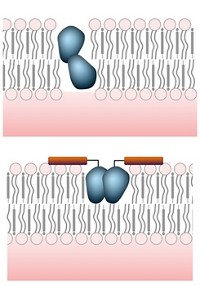Advertisement
Grab your lab coat. Let's get started
Welcome!
Welcome!
Create an account below to get 6 C&EN articles per month, receive newsletters and more - all free.
It seems this is your first time logging in online. Please enter the following information to continue.
As an ACS member you automatically get access to this site. All we need is few more details to create your reading experience.
Not you? Sign in with a different account.
Not you? Sign in with a different account.
ERROR 1
ERROR 1
ERROR 2
ERROR 2
ERROR 2
ERROR 2
ERROR 2
Password and Confirm password must match.
If you have an ACS member number, please enter it here so we can link this account to your membership. (optional)
ERROR 2
ACS values your privacy. By submitting your information, you are gaining access to C&EN and subscribing to our weekly newsletter. We use the information you provide to make your reading experience better, and we will never sell your data to third party members.
Biological Chemistry
Frogs Inspire New Antimicrobials
ACS Meeeting News: Amino acid substitutions boost natural peptides’ germ-killing abilities and reduce side effects
by Sophie L. Rovner
September 13, 2010
| A version of this story appeared in
Volume 88, Issue 37

Frogs probably aren’t the first organisms you’d think of recruiting for help in battling multi-drug-resistant superbugs, but you might reconsider once you realize that these amphibians live under warm, wet, and dirty conditions in which bacteria and fungi thrive.

J. Michael Conlon, a biochemist at United Arab Emirates University, in Al Ain, Abu Dhabi, recognized the potential of frog-inspired antimicrobial compounds back in the late 1990s and has been analyzing and refining these substances ever since. He described his work during a symposium on peptides for disease control presented before the Division of Agricultural & Food Chemistry at last month’s American Chemical Society national meeting in Boston.
Conlon opened his presentation with a warning: “The emergence of drug-resistant pathogenic microorganisms constitutes a serious threat to public health,” he said. “Physicians are increasingly seeing patients with infections that just won’t respond to any available resources.”
Diabetic patients are particularly vulnerable because they often develop foot ulcers that are difficult to heal. Unless these open sores are treated successfully, they can lead to severe, drug-resistant infections that necessitate foot or leg amputation.
The general population is also threatened by superbugs. Methicillin-resistant Staphylococcus aureus (MRSA) and multi-drug-resistant Acinetobacter baumannii (MDRAB), which were initially associated with infections acquired by hospital patients, are now circulating in the community at large, Conlon noted. “They are producing infections in otherwise healthy individuals who are not immunocompromised, which is a scary situation,” he said.
These drug-resistant bacteria have arisen at a particularly inopportune time. “In the 1980s, drug companies developed a series of very powerful, broad-spectrum antibiotics, and it was thought that infectious diseases would be a thing of the past,” Conlon said. “That’s clearly not the case. But a lot of drug companies shut down their anti-infective pharmaceutical sections and transferred their R&D personnel to alternative projects, with the result that until recently, there were no new kinds of antibiotics that we could use to treat these drug-resistant bacteria.”
And that’s where frogs enter the story. The innate immune system of frogs—and indeed many other organisms including butterflies and mammals—continuously produces antimicrobial peptides that serve as a first line of defense against microorganisms, Conlon said. In response to stress, glands in the skin of some frogs exude these peptides, which have broad-spectrum antibacterial and antifungal activity.
The frog peptides are typically eight to 48 amino acids long, possess hydrophobic regions thanks to several leucine and isoleucine residues, yet have a net positive charge at physiological pH because they contain multiple lysine residues.
When the peptides encounter a cell membrane, they take on an α-helical structure that’s amphipathic, meaning one face of the helix is hydrophobic and the opposite face is hydrophilic.
If enough antimicrobial peptide molecules accumulate, they can kill cells. Some peptides are thought to kill by forming transmembrane pores through which cellular components leak out, Conlon said. Other peptides destroy cells by breaking apart cell membranes.
Although the frog peptides’ destructive tendency is beneficial for fighting dangerous microorganisms, the compounds have some shortcomings. They can harm the host animal’s own cells through processes such as hemolysis, the destruction of blood cells. “It’s not a great idea to cure the infection but kill the patient at the same time,” Conlon noted wryly. The peptides also tend to clear rapidly from the circulation because they’re cleaved into inactive fragments by enzymes in blood.
These characteristics limit the natural peptides’ utility as antimicrobials for humans. Conlon and his colleagues therefore set out to synthesize analogs that would preserve or even enhance the compounds’ bug-fighting capabilities while reducing their hemolytic properties.
Membranes of bacterial cells contain a higher percentage of negatively charged phospholipids than do mammalian cell membranes. So Conlon figured that making a peptide more cationic would promote its interaction with bacterial rather than mammalian cell membranes, thereby increasing antimicrobial potency and reducing damage to mammals through hemolysis.
To test his hypothesis, Conlon’s team made a series of analogs of temporin-DRa, a broad-spectrum antimicrobial peptide produced by the California red-legged frog. In each analog, the researchers inserted a lysine, which is positively charged, in place of one of the 14 original amino acids. When they substituted a lysine for a valine at position seven in the middle of the peptide, they were delighted to find that the derivative retained the antimicrobial activity of the original compound but had shed its hemolytic behavior. When the researchers instead replaced an adjacent asparagine with lysine, the resulting analog had twice the antimicrobial activity of the parent compound—but also twice its hemolytic activity.
The easiest way to understand the basis for these changes, Conlon said, is to picture the molecule as a helical wheel with side chains radiating perpendicular to the wheel, and then look down the barrel of the helix. “When we put a lysine at position seven, we not only increase the peptide’s positive charge and reduce the hydrophobicity, we also increase the angle between the positively charged side chains of these basic amino acids,” Conlon explained. “In other words, we spread out the positive charge over a greater region of the molecule, reducing the degree of amphipathicity.” In contrast, he said, putting a lysine at position eight confines the positive charge to a very small patch on the peptide, which increases both its hemolytic and antimicrobial activity because the amphipathicity increases.
Conlon’s group has performed a variety of amino acid substitutions in several other amphibian peptides, including compounds produced by the North American mink frog (Chem. Biol. Drug Des. 2009, 74, 488), the African clawed frog (Biochim. Biophys. Acta 2010, 1804, 1020), and the midwife toad (Peptides, DOI: 10.1016/j.peptides.2010.06.032). Some of the resulting analogs show promise in killing multiple types of bacteria and fungi, such as MRSA, MDRAB, and microbes collected from diabetic patients’ infected foot ulcers, Conlon said.
For now, he thinks such compounds will be best suited for topical applications, including the treatment of foot ulcers, dermatitis, and acne, and the promotion of wound healing.





Join the conversation
Contact the reporter
Submit a Letter to the Editor for publication
Engage with us on Twitter